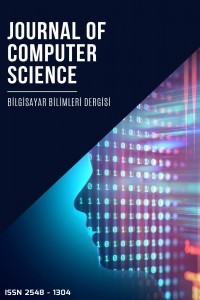Nesnelerin İnternetinde Dallanmasız Programlama Tekniklerinin Uygulanması
Dallanmasız Programlama, Nesnelerin İnterneti, Optimizasyon, Karmaşıklık
Application of Branchless Programming in Internet of Things
Branchless Programming, Internet of Things, Optimization, Complexity,
___
- Chowdhury, M. R., Tripathi, S., & De, S. (2020). Adaptive multivariate data compression in smart metering Internet of Things. IEEE Transactions on Industrial Informatics, 17(2), 1287-1297.
- HaddadPajouh, H., Dehghantanha, A., Parizi, R. M., Aledhari, M., & Karimipour, H. (2021). A survey on internet of things security: Requirements, challenges, and solutions. Internet of Things, 14, 100129.
- J. Gubbi, R. Buyya, S. Marusic, and M. Palaniswami, “Internet of things (iot): A vision, architectural elements, and future directions,” Future Generation Computer Systems, vol. 29, no. 7, pp. 1645–1660, 2013.
- Khan, M. Z., Alhazmi, O. H., Javed, M. A., Ghandorh, H., & Aloufi, K. S. (2021). Reliable Internet of Things: Challenges and future trends. Electronics, 10(19), 2377.
- Li, X., Liu, Y., Ji, H., Zhang, H., & Leung, V. C. (2019). Optimizing resources allocation for fog computing-based Internet of Things networks. IEEE Access, 7, 64907-64922.
- Mangla, M., Kumar, A., Mehta, V., Bhushan, M., & Mohanty, S. N. (Eds.). (2022). Real-life applications of the Internet of Things: Challenges, applications, and advances.
- Qadri, Y. A., Nauman, A., Zikria, Y. B., Vasilakos, A. V., & Kim, S. W. (2020). The future of healthcare internet of things: a survey of emerging technologies. IEEE Communications Surveys & Tutorials, 22(2), 1121-1167.
- R. Want and S. Dustdar, “Activating the internet of things [guest editors’ introduction],” Computer, vol. 48, no. 9, pp. 16–20, 2015.
- Wang, Z., Liu, Y., Sun, Y., Li, Y., Zhang, D., & Yang, H. (2015, May). An energy-efficient heterogeneous dual-core processor for Internet of Things. In 2015 IEEE international symposium on circuits and systems (ISCAS) (pp. 2301-2304). IEEE.
- Zafar, S., Bhatti, K. M., Shabbir, M., Hashmat, F., & Akbar, A. H. (2022). Integration of blockchain and Internet of Things: Challenges and solutions. Annals of Telecommunications, 1-20.
- ISSN: 2548-1304
- Yayın Aralığı: Yılda 2 Sayı
- Başlangıç: 2016
- Yayıncı: Ali KARCI
Improved Reptile Search Algorithm for Optimal Design of Solar Photovoltaic Module
Davut İZCİ, Serdar EKİNCİ, Murat GÜLEYDİN
Gauss Filtreleme ve ResNET50 Modeli Kullanılarak Beyin Tümörlerinin Sınıflandırılması
Tweet Toplama, Analiz ve Depolama için Platform Tasarımı (TweetCASP)
Tugba Beril DOGUC, Ahmet Arif AYDIN
Yeşil Tedarikçi Seçiminde Hibrit Bulanık AHP ve Bulanık QFD Yaklaşımının Kullanılması
Candan UÇKUN, Nurdan DALGIÇ, Aytaç YILDIZ
Nesnelerin İnternetinde Dallanmasız Programlama Tekniklerinin Uygulanması
Muhammed Saadetdin KAYA, Kenan İNCE
Elma Yaprağı Hastalıklarının AlexNet Kullanılarak Derin Öğrenme Tabanlı Sınıflandırılması
Felix Olanrewaju BABALOLA, Nekabari Isabella KPAİ, Önsen TOYGAR
Sayısal Global Optimum için Çift-Girişim Tabanlı İyileştirme Algoritmasının Yakınsama Analizi
